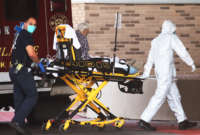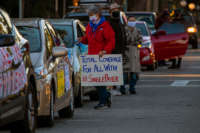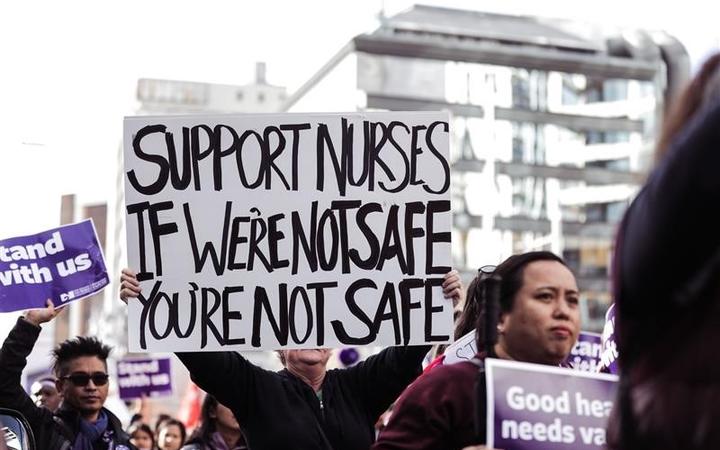
A new film called “Takeover” follows the 12 historic hours on July 14, 1970, when members of the Young Lords Party took over the rundown Lincoln Hospital in the South Bronx in New York City. The Young Lords were a radical group founded by Puerto Ricans modeled on the Black Panther Party. Democracy Now! co-host Juan González, a co-founder of the Young Lords, helped organize the action. Using archival footage and modern-day interviews, “Takeover” chronicles their resistance to institutions founded on wealth and white supremacy, and their collective struggle for quality, accessible healthcare. “The takeover really exemplified what the Young Lords were about,” says director Emma Francis-Snyder, who says she wanted to capture the heroism of the activists. “There’s so much emotion and planning and courage that comes along with direct action,” Francis-Snyder says. “We understood that to get the system to listen and change, you had to disrupt it,” adds González. “You had to find a way to force people to pay attention to the problems.”
TRANSCRIPT
This is a rush transcript. Copy may not be in its final form.
AMY GOODMAN: This is Democracy Now!, democracynow.org. I’m Amy Goodman, with Juan González.
We look now at an extraordinary new documentary called Takeover, that follows the 12 historic hours, July 14th, 1970, when members of the Young Lords took over the rundown Lincoln Hospital in the South Bronx. The Young Lords were a radical group founded by Puerto Ricans modeled on the Black Panther Party. They drove out the administrative staff of the hospital, barricaded the entrances, made their cries for decent healthcare known to the world. This is the trailer to the film Takeover.
NARRATOR: This is a story from New York, not the New York of Manhattan’s Broadway, but for perhaps the toughest square mile in the city, in the South Bronx.
CARLITO ROVIRA: I was 14 years old when I joined the Young Lords. The Young Lords were a street gang that became politicized by the Black Panther Party.
We became visible as servants of the people.
One of our targets was Lincoln Hospital.
IRIS MORALES: That building was condemned 25 years ago. Condemned. Condemned for rich people and opened for poor people.
UNIDENTIFIED: It was a place that you went to to die.
UNIDENTIFIED: Lincoln was called the “butcher shop.”
MIGUEL ”MICKEY” MELENDEZ: Bloodstains on the walls. Bloodstains on the floors.
UNIDENTIFIED: And there was a rat in the emergency room.
DR. LEWIS FRAAD: We have seen children get lead poisoning while hospitalized at Lincoln Hospital.
JUAN GONZÁLEZ: We felt now was the time for us to say exactly how we’re going to respond to the killings of our people.
CARLITO ROVIRA: Our plan was to take over Lincoln Hospital.
JUAN GONZÁLEZ: We have to begin to stand up for the people, the Puerto Rican people, and say, “That’s enough. That’s enough.”
CLEO SILVERS: We have been asking for changes to take place. And you’ve paid no attention to us. You’ve thrown us out of your offices, and you’ve called the cops on us. And now we’re putting you out. We’ve taken over the hospital. We’re going to run it. You’re out. And I will walk you to your car.
JUAN GONZÁLEZ: We immediately announced that we were not leaving until the city made a firm commitment to build a new hospital.
About a thousand police were on roofs with high-powered rifles. They had vans all over the place.
If the police came in, it was going to be a bloodbath, because the police hated the Young Lords.
CLEO SILVERS: We were terrified.
JUANGONZÁLEZ:“Power to the people” means including people to gain control of their destiny.
The Young Lords were ahead of our time in terms of recognizing that healthcare is a right.
DENISEOLIVER–VELEZ:We wanted a revolutionary change to the health system in this country. And we still do.
CARLITOROVIRA:Because no oppressor is invincible.
AMY GOODMAN: The trailer to the film Takeover. And one of the voices and images you heard and saw was Democracy Now! co-host Juan González, co-founder of the Young Lords, who helped organize the action. In this clip from the film, we hear other Young Lords explain how the group started in New York. This is Felipe Luciano, Miguel “Mickey” Melendez and Denise Oliver-Velez. We hear first from Iris Morales.
IRIS MORALES: The Young Lords didn’t drop from the sky one day and all of this happened. We were part of a continuum of history, of a legacy that had gone before us.
For that revolution that’s within the United States, we see ourselves hooking up with Black people, with Native Americans, with Asians, with other Latinos to form a united front as oppressed people to wage against the real enemy.
I started out as a cadre in the Young Lords in 1969. I became deputy minister of education. I was a co-founder of the women’s caucus.
FELIPE LUCIANO: I was the first chairman of the Young Lords Party.
We are ideological in that we believe in the principles of socialism, in that we believe in cooperative effort, in that we believe in unified struggle.
MIGUEL”MICKEY”MELENDEZ:It’s all about pride. It’s all about community. It’s all about being together. I was one of the co-founders of the Young Lords Organization in New York City.
DENISEOLIVER–VELEZ:When you joined to be a full Young Lord, you left home, you quit your job. If your family didn’t — if you had a spouse or whatever that didn’t want to be a part of it, you left them. So, when we said you’re a Young Lord 25 hours a day, we meant it.
I became the first woman on the central committee of the Young Lords.
We were coming from a place of love and of respect. But we also didn’t take any [bleep].
AMY GOODMAN: That’s from Takeover. Well, for more, we’re joined by Emma Francis-Snyder, the director of this new short documentary. The film premieres this Friday at the Tribeca Film Festival, will be available to stream online starting Saturday. And, of course, we’re joined right here by co-host Juan González, co-founder of the Young Lords, who was one of those who took over the hospital.
But, Emma, let’s start with you on why you decided to focus on the Lincoln Hospital takeover and, through it, tell this remarkable story of the Young Lords, through incredible archival footage but also reenactments that look like they were archival footage.
EMMA FRANCIS–SNYDER: First of all, thank you so much for having me. This is a dream come true. So, thank you.
You know, for me, the takeover really exemplified what the Young Lords were about. It was not only the biggest, like the largest takeover at the time, but it also had some very concrete, real results, which was, essentially, a new hospital, the Patient Bill of Rights and, ultimately, a call for universal healthcare and community control. And for me, as a young activist that wanted to learn, this kind of started off as my own process of wanting to learn and understand about successful modes of direct action.
And what I found at Lincoln Hospital was like this beautiful cross-section of life and collaborativeness that cut across socioeconomic and racial lines, and in which the community and the workers led and the doctors and residents followed. And I felt like it was just a really beautiful way that we saw — that I saw for people to support and follow community control in a way that was really successful.
And then, on top of it, just as like a filmmaker, it’s a beautiful story, right? You know, we think of cops and robbers and heists as things that don’t actually happen, but, like, there’s so much emotion and planning and courage that comes along with direct action. And I really wanted to sit in those moments and exemplify, like, what it takes to do something like this, not just the planning, not just the thought leading up to it, but like the feelings. I mean, there was a face-off. They took over a building, and there was a face-off with the police. I mean, it’s just like — it is a story in and of itself.
AMY GOODMAN: Juan, it is an astounding story, and it’s your story, Juan. Talk about why you chose Lincoln Hospital, what were the demands, and what these 12 hours, once you marched in — the response of the hospital staff — I mean, operations are going on, etc.
JUAN GONZÁLEZ: Well, I think the reason we took the hospital is because we had been involved — and I think it’s underappreciated, the amount of work that the Young Lords did in what we would normally call today public health. It was not just the issue of the treatment in the hospital and the services in a dilapidated, rundown hospital that the city had been promising to tear down for decades but hadn’t done, but it was also all of the work that we did in lead poison detection, tuberculosis detection, drug detoxification, acupuncture, using acupuncture for the first time in drug treatment, that was developed by the Lords and the Panthers at Lincoln Hospital, that there was — in other words, health was a major, major concern of ours at the time.
But we understood that to get the system to listen and change, you had to disrupt it. You had to find a way to force people to pay attention to the problem. So I think that’s the main thrust of all of our actions that we took in this wide area of public health at the time.
AMY GOODMAN: And one of the stories that Emma tells so well, that you were involved with, was the hijacking of a tuberculosis truck. If you could explain, Juan?
JUAN GONZÁLEZ: Well, we wouldn’t call it “hijacking.” We called it “liberating,” the liberating of a tuberculosis truck. That was, the city was misusing and wouldn’t provide in the East Harlem and South Bronx communities, so we redirected the route of the truck in order to be able to test more people who were actually at the center of what was then a tuberculosis epidemic in the city.
But I wanted to ask Emma, because, Emma, you interviewed me — I guess it was about 10 years ago, when you were first starting this project.
EMMA FRANCIS–SNYDER: Yes.
JUAN GONZÁLEZ: And I have to tell you, I’ve been very impressed by the result of your work, especially in the recreations, because for a while, when I first saw your final version, I thought you had somehow found footage of what we had done back then that I was not aware of. It turns out then that you basically had some actors recreate some of these scenes. But they were so well done, and even some of the characters resembled so much younger versions of Cleo Silvers or Carlito Rovira that I first thought that this was actually archival footage. I’m wondering about the decision to take that route in terms of telling the story.
EMMA FRANCIS–SNYDER: Yeah, absolutely. I think that I — you know, while this is a true story, I think that it also had — as I referred to earlier, it had all these cinematic elements, right? And it’s like, what does it look like taking over a hospital? Like, there is that drama, the tension. And I really wanted us, the audience, to live and breathe in those moments with you,, because so much of the time things like this may get glossed over, and I just really wanted to sit in it and have the audience feel all of these feelings.
I really have to credit the director — I mean, the cinematographer, Tine DiLucia. She and I worked together and really, you know — and honoring the Third World Newsreel movement at that time, honestly. Like, this is directly related to and taken — the style taken from the work that was done, and so just referencing that.
AMY GOODMAN: Well, I want to go to another clip from the documentary, Takeover. The voices include Juan, Juan González, as well as the former New York mayor — deputy mayor, Sid Davidoff, under Lindsay. It begins with Pablo Guzmán, known as Yoruba, the Young Lords minister of information, speaking to reporters during the takeover of Lincoln Hospital.
REPORTER: Yoruba, what’s happened?
PABLO ”YORUBA” GUZMÁN: What’s happening now is that while we were negotiating and while we were trying to reach some kind of a settlement, the first thing that we had come up with was that we would be clear and we would be free to negotiate as long as they moved the pigs back. They said they were going to move the pigs back. And while they were saying this, they tried to sneak a pig in to yank one of the Lords out, to yank one of our brothers out. As this was going down, we then had to tell them, “Look, we know where you’re at. This is a breach of good faith. We can’t deal anymore.” I’m going have to leave now, because they’re trying to mobilize now, and I have to go deal.
UNIDENTIFIED: Mark, the police are coming out right now.
DEPUTY MAYOR SIDNEY DAVIDOFF: We say, look, this is real simple. If we don’t resolve this with you right now, the next thing to come is the guys with the guns. You don’t want the guys with the guns coming in here.
JUANGONZÁLEZ:The police hated the Young Lords. And they’d love the opportunity to get us all in one place.
JEFFKAMEN:Because the Young Lords had seen the killing of Fred Hampton, the leader of the Chicago Black Panthers, by the police officers, they had reason to be afraid.
CLEOSILVERS:We were terrified that they were going to come in there and they were going to beat us into pulp, and no one was going to help us.
AMY GOODMAN: Those last voices, Cleo Silvers and reporter Jeff Kamen, who are featured in the documentary Takeover. Juan, I mean, let’s talk about that time, what you faced as you’re moving into this hospital. Yes, this was about half a year after the police murder of Fred Hampton and Mark Clark in Chicago. You didn’t know if you would be shot, if you would be arrested, if you would be killed.
JUAN GONZÁLEZ: Well, I think the lesson of this for us then and, I think, for activists today is that we were trying to negotiate with the Lindsay administration, which was ostensibly a liberal Republican in those days — there aren’t any liberal Republicans today, but back then there were some — and the question was really to what degree did the mayor of the city control his own police department. And it became increasingly clear, as we negotiated, that he didn’t really control the police department and that the police department had a mind of its own. And so we had to deal with the reality that even if we wanted to negotiate and the Lindsay administration did, the police department had other ideas.
So we had to take that into account in trying to figure out what to do at that stage, once we had spread the message throughout the city and the country about the occupation and the issues involved. And so, we chose, at a certain point, after getting a verbal commitment from the administration that if we left and if we — they couldn’t announce anything at the time, but if we left the hospital, that they would indeed build a new Lincoln Hospital. And they did build a new Lincoln Hospital shortly thereafter. But we then had to decide to either have a complete standoff, and many people injured or hurt, or figure out a way to get out of the hospital while the police surrounded it. And I think Emma did a very good job in terms of telling the story of how that happened —
AMY GOODMAN: And that amazing escape —
JUAN GONZÁLEZ: — and that, miraculously, no one was hurt, and we all managed to get out. No one was arrested.
AMY GOODMAN: And that amazing escape in white coats was incredible. Emma, we just have 10 seconds. How do people get to see this film at the Tribeca Film Festival and beyond?
EMMA FRANCIS–SNYDER: You can watch it virtually. All of our screenings are sold out. So if you just go to the Tribeca website, “Takeover 2021.” Thank you so much for having me.
AMY GOODMAN: Well, Emma Francis-Snyder, director of the new short film Takeover. It premieres Friday at the Tribeca Film Festival. And, Juan, amazing. That does it for the show. I’m Amy Goodman, with Juan González. Thank you so much for joining us. Stay safe.
This post was originally published on Latest – Truthout.









